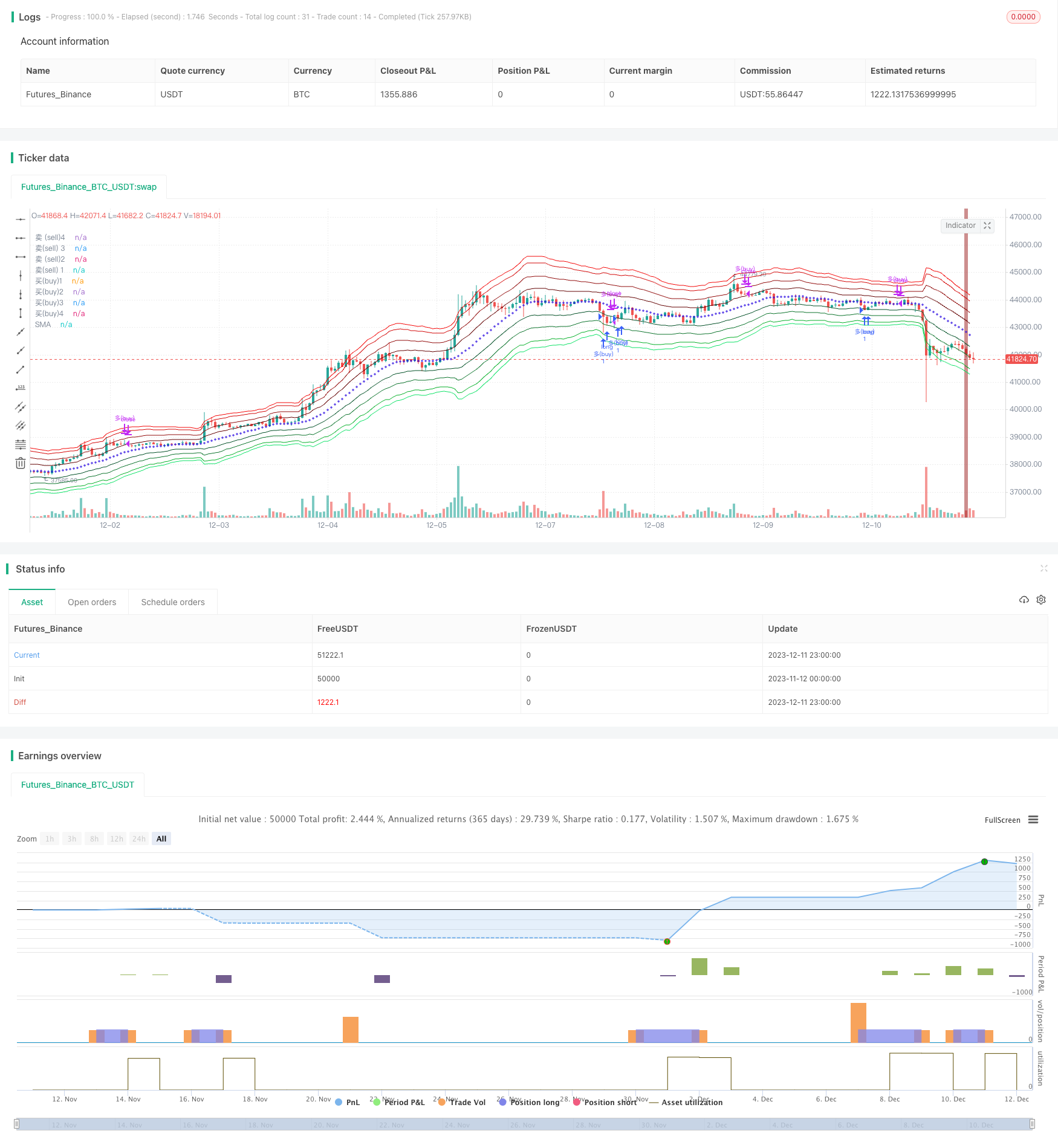
概述
本策略运用布林通道指标绘制出基于ATR和Fibonacci回归的波段作为网格的价格通道。结合双EMA均线判断整体趋势方向,在趋势方向选择性地在布林波段价格上设置追踪止损网格,实现趋势追踪套利。
策略原理
使用布林通道中轴线及基于ATR和4条Fibonacci回归线绘制上下轨构建价格波段。
快线EMA和慢线SMA组成双均线判断整体趋势方向。快线突破慢线为多头市场,反之为空头市场。
在多头市场中仅做多,选择布林下轨附近价格突破通道下沿开仓做多;在空头市场中仅做空,选择布林上轨附近价格突破通道上沿开仓做空。
设置止损条件:出现大幅反转K线即退出当前方向仓位。
优势分析
使用双均线判断大级别趋势,避免逆势交易。
布林ATR通道网格设置了多条开仓价格,增加了开仓成功率。
Fibonacci回归波段设置了价格离散度,不同波段仓位数量不同,实现了资金分散。
实时止损条件便于快速止损,降低盈利回吐。
风险分析
大级别趋势判断错误,可能导致逆势亏损。可适当调整均线参数,或者增加其他指标进行辅助判断。
波动过大时,价格可能直接突破网格区,无法开仓。可调整波段参数,增加开仓机会。
止损条件较为主观,不同交易者的识别标准可能存在误差。建议测试并优化止损条件。
优化方向
增加apo指标进行双均线趋势判断的辅助分析。
使用市场波动率指标优化布林波段参数,使其更好地适应市场的动态变化。
调小止损幅度,并加入OTHER方式的止损条件设定,降低误差。
总结
本策略整体思路清晰,使用布林ATR通道和双均线结合实现了策略交易信号的全面综合判断,最大程度地减少了误判风险。策略优势明显,可实际应用;但细节点如参数设置和止损条件仍有优化空间,有待进一步完善。相信在不断优化中,本策略的盈利水平和稳定性都将不断提升。
策略源码
/*backtest
start: 2023-11-12 00:00:00
end: 2023-12-12 00:00:00
period: 1h
basePeriod: 15m
exchanges: [{"eid":"Futures_Binance","currency":"BTC_USDT"}]
*/
// This source code is subject to the terms of the Mozilla Public License 2.0 at https://mozilla.org/MPL/2.0/
// © Aayonga
//@version=5
strategy("fib trend grid@Aa", overlay=true,initial_capital=2000, default_qty_type=strategy.fixed, default_qty_value=1)
//回测时间
useDateFilter=input.bool(true,title = "启用回测时间范围限定(backtest)", group = "回测范围(backtest)")
backtesStarDate=input(timestamp("1 Jan 2015"),title = "开始时间(Start)", group = "回测范围(backtest)")
backtestEndDate=input(timestamp("1 Jan 2040"),title = "结束时间(finish)",group = "回测范围(backtest)")
inTradeWindow=true
//入场位 entry
bolllen=input.int(defval=20,minval=1,title="布林长度,(boll length)",group = "入场位(entry)")
sma=ta.sma(close,bolllen)
avg=ta.atr(bolllen)
fib1=input(defval=1.236,title="Fib 1",group = "入场位(entry)")
fib2=input(defval=2.382,title="Fib 2",group = "入场位(entry)")
fib3=input(defval=3.618,title="fib 3",group = "入场位(entry)")
fib4=input(defval=4.236,title="Fib 4",group = "入场位(entry)")
r1=avg*fib1
r2=avg*fib2
r3=avg*fib3
r4=avg*fib4
top4=sma+r4
top3=sma+r3
top2=sma+r2
top1=sma+r1
bott1=sma-r1
bott2=sma-r2
bott3=sma-r3
bott4=sma-r4
//趋势 trend
t4=plot(top4,title="卖 (sell)4",color=color.rgb(244, 9, 9))
t3=plot(top3,title = "卖(sell) 3",color=color.rgb(211, 8, 8))
t2=plot(top2,title="卖 (sell)2",color=color.rgb(146, 13, 13))
t1=plot(top1,title="卖(sell) 1",color=color.rgb(100, 3, 3))
b1=plot(bott1,title="买(buy)1",color=color.rgb(4, 81, 40))
b2=plot(bott2,title="买(buy)2",color=color.rgb(15, 117, 46))
b3=plot(bott3,title = "买(buy)3",color =color.rgb(8, 176, 42) )
b4=plot(bott4,title="买(buy)4",color=color.rgb(15, 226, 103))
plot(sma,style=plot.style_cross,title="SMA",color=color.rgb(47, 16, 225))
//趋势
LengthF=input(defval = 25,title = "快线长度(fastlength)")
LengthS=input(defval=200,title = "慢线长度(slowlength)")
emaF=ta.ema(close,LengthF)
smaS=ta.sma(close,LengthS)
longTrend=emaF>smaS
longb=ta.crossover(emaF,smaS)
bgcolor(longb ? color.new(color.green,40):na,title = "多头强势(bull trend)")
shortTrend=smaS>emaF
shortb=ta.crossunder(emaF,smaS)
bgcolor(shortb ? color.new(#951313, 40):na,title = "空头强势(bear trend)")
//pinbar
bullPinBar = ((close > open) and ((open - low) > 0.6* (high - low))) or ((close < open) and ((close - low) > 0.9 * (high - low)))
//plotshape(bullPinBar , text ="pinbar", textcolor=color.rgb(9, 168, 144),location=location.belowbar, color=color.rgb(29, 103, 67), size=size.tiny)
bearPinBar = ((close > open) and ((high - close) > 0.7 * (high - low))) or ((close < open) and ((high - open) > 0.7 * (high - low)))
//plotshape(bearPinBar , text ="pinbar", textcolor=color.rgb(219, 12, 12),location=location.abovebar, color=color.rgb(146, 7, 7), size=size.tiny)
buy1=ta.crossunder(close,bott1) and longTrend and close>ta.ema(close,100)
buy2=ta.crossunder(close,bott2) and longTrend and close>ta.ema(close,80)
buy3=ta.crossunder(close,bott3) and longTrend and close>ta.ema(close,80)
buy4=ta.crossunder(close,bott4) and longTrend and close>ta.ema(close,80)
buyclose=bearPinBar or ta.crossunder(close,smaS)
if buy2 or buy3 or buy4 or buy1 and inTradeWindow
strategy.order("多(buy)",strategy.long)
if buyclose and inTradeWindow
strategy.close("多(buy)")
sell1=ta.crossover(close,top1) and shortTrend and close<ta.ema(close,200)
sell2=ta.crossover(close,top2) and shortTrend and close<ta.ema(close,200)
sell3=ta.crossover(close,top3) and shortTrend and close<ta.ema(close,200)
sell4=ta.crossover(close,top4) and shortTrend and close<ta.ema(close,200)
sellclose=bullPinBar or ta.crossover(close,ta.sma(close,220))
if sell1 or sell2 or sell3 or sell4 and inTradeWindow
strategy.order("空(sell)",strategy.short)
if sellclose and inTradeWindow
strategy.close("空(sell)")